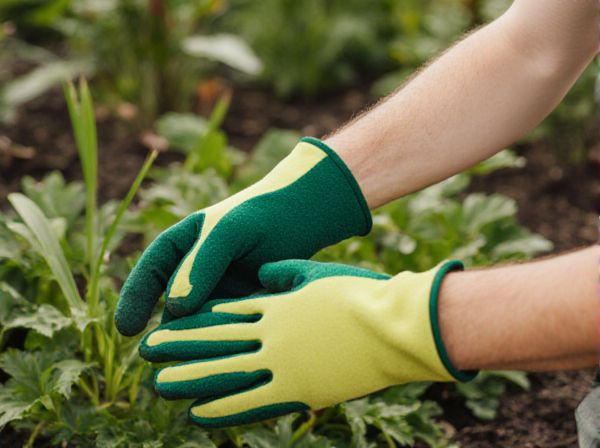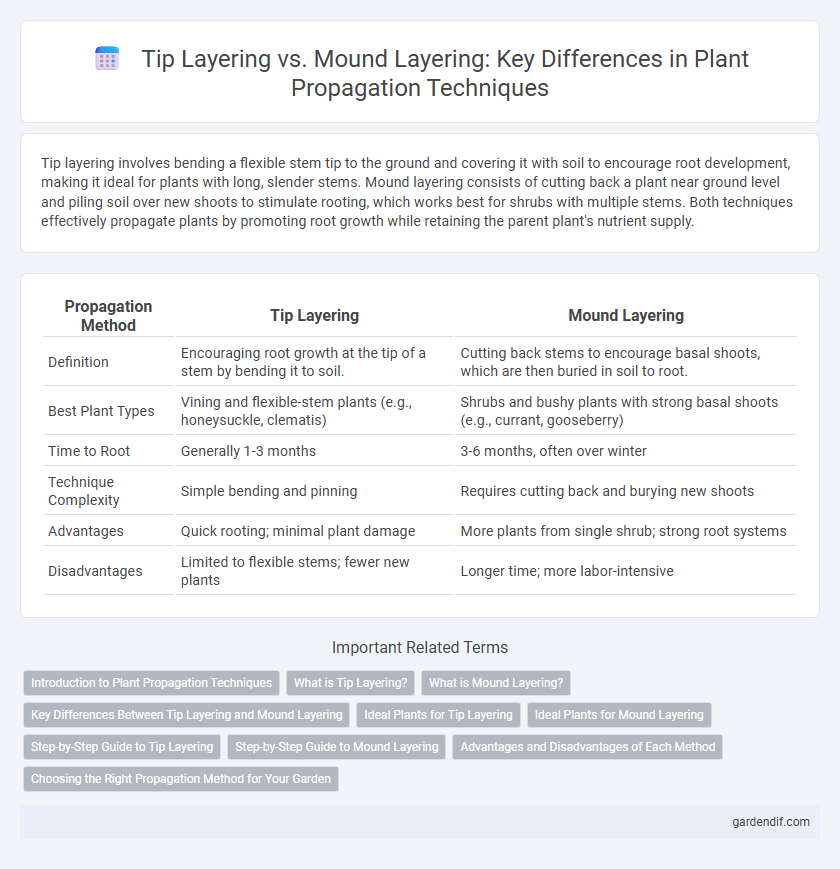
Tip Layering vs Mound Layering Illustration
Tip layering involves bending a flexible stem tip to the ground and covering it with soil to encourage root development, making it ideal for plants with long, slender stems. Mound layering consists of cutting back a plant near ground level and piling soil over new shoots to stimulate rooting, which works best for shrubs with multiple stems. Both techniques effectively propagate plants by promoting root growth while retaining the parent plant's nutrient supply.
Table of Comparison
| Propagation Method | Tip Layering | Mound Layering |
|---|---|---|
| Definition | Encouraging root growth at the tip of a stem by bending it to soil. | Cutting back stems to encourage basal shoots, which are then buried in soil to root. |
| Best Plant Types | Vining and flexible-stem plants (e.g., honeysuckle, clematis) | Shrubs and bushy plants with strong basal shoots (e.g., currant, gooseberry) |
| Time to Root | Generally 1-3 months | 3-6 months, often over winter |
| Technique Complexity | Simple bending and pinning | Requires cutting back and burying new shoots |
| Advantages | Quick rooting; minimal plant damage | More plants from single shrub; strong root systems |
| Disadvantages | Limited to flexible stems; fewer new plants | Longer time; more labor-intensive |
Introduction to Plant Propagation Techniques
Tip layering involves bending a plant's stem tip to the soil surface where it forms roots, ideal for shrubs with flexible branches. Mound layering promotes root growth by cutting back a plant and covering new shoots with soil, useful for plants like currants and gooseberries. Both methods leverage natural rooting processes to propagate plants efficiently without requiring specialized equipment.
What is Tip Layering?
Tip layering is a propagation technique where the tip of a stem is bent down to the soil surface and covered to encourage root formation while still attached to the parent plant. This method stimulates new plant growth from the rooted tips, allowing plants like blackberries and raspberries to multiply effectively. It is ideal for species with flexible, trailing stems that root easily when in contact with moist soil.
What is Mound Layering?
Mound layering is a horticultural propagation technique where soil is heaped around the base of a plant to encourage root formation on buried stems. This method is commonly used for woody shrubs and fruit trees, promoting strong root systems before separation from the parent plant. Mound layering enhances successful propagation by ensuring nutrient access and protection for developing roots.
Key Differences Between Tip Layering and Mound Layering
Tip layering involves bending a plant stem tip into the soil to encourage root development at the tip, typically used for trailing shrubs and vines. Mound layering requires cutting back a plant to encourage multiple new shoots that are buried with soil, promoting rooting at the base and suitable for woody shrubs. Key differences include the part of the plant used for rooting--tip versus base--and the growth habit, with tip layering allowing continued upward growth while mound layering results in multiple new plants from one.
Ideal Plants for Tip Layering
Tip layering is ideal for plants with flexible, low-hanging branches such as blackberries, raspberries, and wisteria, which naturally root when the branch tip is buried. This method suits species that produce vigorous shoots and have a high rooting capacity at the branch tips. In contrast, mound layering is better for woody shrubs like currants and gooseberries that develop multiple shoots from the base, making tip layering less effective for these plants.
Ideal Plants for Mound Layering
Ideal plants for mound layering include woody shrubs and vines such as currants, gooseberries, and blackberries due to their low, flexible stems that root easily when buried. Mound layering works best with species that naturally form dense, arching growth or have multiple stems close to the ground, enabling new roots to develop from buried shoots. This method is particularly effective for propagating plants with vigorous growth and a tendency to produce shoots near the soil surface.
Step-by-Step Guide to Tip Layering
Tip layering involves bending a low-growing stem to the soil surface and covering the tip with soil while leaving the parent plant attached to ensure nutrient flow for root development. Begin by selecting a healthy, flexible shoot, then create a shallow trench where the stem tip will be buried, gently secure it with a pin or stone, and cover the tip with 2-3 inches of soil. Maintain moisture until new roots form, typically in a few weeks, before severing the new plant from the parent for transplanting.
Step-by-Step Guide to Mound Layering
Mound layering involves bending a low-growing stem to the ground and covering it with soil to encourage root development while the parent plant remains intact. To successfully mound layer, select a healthy stem, create a small mound of soil around the base, bury the stem at the mound, and secure it with a pin or stone to maintain contact with soil. Roots typically form in several weeks, after which the new plant can be severed from the parent and transplanted.
Advantages and Disadvantages of Each Method
Tip layering enables faster root development by bending and burying a stem tip, making it ideal for plants with flexible branches, but it risks stem damage and limited plant size. Mound layering involves cutting the main stem near soil level and piling soil around the sprouts, promoting robust root systems and higher plant density, though it requires more space and longer establishment time. Each method suits different plant types and cultivation goals, with tip layering favoring quicker propagation and mound layering enhancing root strength and biomass.
Choosing the Right Propagation Method for Your Garden
Tip layering is ideal for plants with flexible, low-growing branches that easily root when buried, providing a natural method for propagation with minimal disturbance. Mound layering suits woody shrubs that produce multiple new shoots from the base, allowing gardeners to cover shoots with soil to encourage root development while maintaining the parent plant's structure. Selecting the right method depends on the plant species' growth habits and the gardener's space constraints, ensuring optimal root formation and successful propagation.
Tip Layering vs Mound Layering Infographic

 gardendif.com
gardendif.com